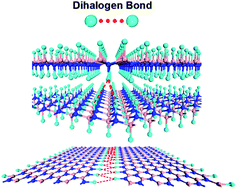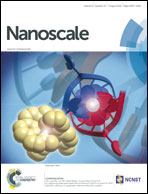Tuning band gaps of BN nanosheets and nanoribbons via interfacial dihalogen bonding and external electric field†
Abstract
Density functional theory computations with dispersion corrections (DFT-D) were performed to investigate the dihalogen interactions and their effect on the electronic band structures of halogenated (fluorinated and chlorinated) BN bilayers and aligned halogen-passivated zigzag BN nanoribbons (BNNRs). Our results reveal the presence of considerable homo-halogen (F⋯F and Cl⋯Cl) interactions in bilayer fluoro (chloro)-BN sheets and the aligned F (Cl)-ZBNNRs, as well as substantial hetero-halogen (F⋯Cl) interactions in hybrid fluoro-BN/chloro-BN bilayer and F–Cl-ZBNNRs. The existence of interfacial dihalogen interactions leads to significant band-gap modifications for the studied BN nanosystems. Compared with the individual fluoro (chloro)-BN monolayers or pristine BNNRs, the gap reduction in bilayer fluoro-BN (B–F⋯F–N array), hybrid fluoro-BN/chloro-BN bilayer (N–F⋯Cl–N array), aligned Cl-ZBNNRs (B–Cl⋯Cl–N alignment), and hybrid F–Cl-ZBNNRs (B–F⋯Cl–N alignment) is mainly due to interfacial polarizations, while the gap narrowing in bilayer chloro-BN (N–Cl⋯Cl–N array) is ascribed to the interfacial nearly-free-electron states. Moreover, the binding strengths and electronic properties of the interactive BN nanosheets and nanoribbons can be controlled by applying an external electric field, and extensive modulation from large-gap to medium-gap semiconductors, or even metals can be realized by adjusting the direction and strength of the applied electric field. This interesting strategy for band gap control based on weak interactions offers unique opportunities for developing BN nanoscale electronic devices.


 Please wait while we load your content...
Please wait while we load your content...